I didn’t grow up eating Hot Cross Buns at Easter. The first time I saw them was on the Great British Bakeoff, and I was immediately intrigued. Since they weren’t easy to find at bakeries here in the US, I decided to try making them myself. These Sourdough Discard Hot Cross Buns put a sourdough spin on the classic. They’re soft and lightly sweet, filled with plump raisins and bits of candied citrus, and finished with the traditional cross on top.

Why I love this recipe
- Uses a combination of commercial yeast and sourdough starter for convenience and flavor.
- Made by hand, no mixer needed!
- Light and airy crumb filled with raisins and candied citrus.
- Delicious enough to enjoy on their own—or even better, slathered with homemade cultured butter.
Ingredients and Substitutions
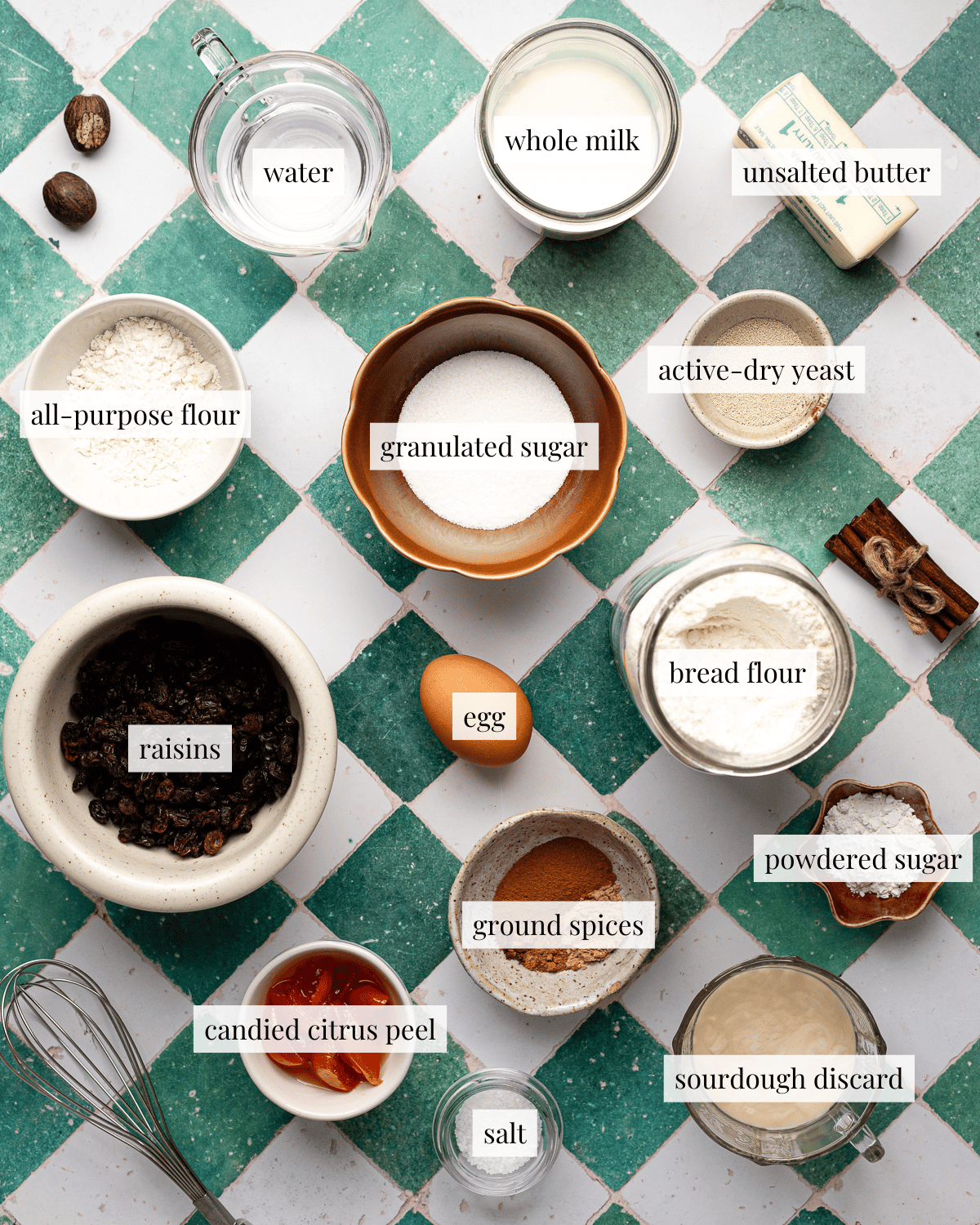
All-purpose flour: All-purpose flour contains 10–12% protein, this low protein content is perfect for creating tender crosses. Do not use bread flour on your crosses or they will be tough and gummy.
Sourdough discard: Both active sourdough starter and sourdough discard will work for this recipe.
Yeast: I used active dry yeast to test this recipe but instant yeast will work as well. You can skip the blooming step if you use instant yeast.
Candied citrus: I used homemade candied kumquats, but you can purchase candied citrus from a specialty grocery store or online.
Powdered sugar: Powdered sugar isn’t traditional for making crosses on hot cross buns, but I find that it makes the crosses more tender and adds a subtle sweetness.
See the recipe card for detailed ingredient information.

Can I make this with a sourdough starter without commercial yeast?
Absolutely! However, you’ll need to adjust your rise time. Dough made with commercial yeast will rise in about 45 minutes to 1 hour, however, if you use your active starter expect proofing to take about 4 to 6 hours.
If you want to a naturally leavened version of this recipe, make sure your starter is mature and active, and give the dough plenty of time to rise. Otherwise, the buns will turn out dense and gummy instead of light and fluffy.
Want to see a version of this recipe using active sourdough starter? Let me know in the comments!
Step-by-step Instructions
Step 1: Make the dough
Bloom the yeast and soak the raisins in water. Dissolve the sourdough discard into the yeast mixture. Stir the flour, spices and salt in until a shaggy dough forms. Knead the butter into the dough. Cover the bowl with plastic wrap and let it rest for 10 minutes.

Step 2: Knead the dough
Drain the liquid from the raisins. Turn the dough out onto a clean surface and knead until smooth. Return the dough to the bowl and fold the raisins and chopped candied citrus into the dough until evenly distributed.

Tip
Kneading the dough first helps keep the raisins and candied citrus intact, preventing them from getting smashed.
Step 3: Bulk fermentation
Gather the dough into a tight ball and transfer it to a clean, lightly oiled bowl. Cover the bowl with plastic wrap and let the dough rise untouched until doubled in volume, about 45 minutes to 1 hour.

Step 4: Shape the dough
Divide the dough into 12 portions. Working with one piece at a time, flatten the dough into a rectangle. Fold the corners toward the center, and pinch them together to seal. Turn the dough over and round it into a tight ball, and try your best to seal the seam on the bottom.

Step 5: Final proof
Arrange the rolls on a 9 by 13-inch baking pan lined with parchment paper. Cover the pan with plastic wrap and let the dough rise untouched until puffy and almost fills the pan.

Step 6: Add the crosses
Make a paste out of the powdered sugar, all-purpose flour and water. Transfer the topping to a piping bag. Pipe crosses over the buns.

Step 7: Bake
Bake the buns at 350 F for 45 to 50 minutes or until golden brown and the temperature of the buns register at 190 F when probed with an instant-read thermometer. Brush the warm buns with simple syrup.

Baker’s Tips
- Weigh your ingredients: Using a scale is far more accurate and consistent than relying on tablespoons or cups. This helps ensure the success of your bakes and produces reliable much more reliable results.
- Use the windowpane test: A great way to check if your dough has developed enough strength. After the last kneading, stretch a small piece of dough between your fingers—if it forms a thin, translucent membrane without tearing, the dough is ready for the next step.
- No sourdough discard: You can use active starter for this recipe or just add 56 grams of water and 56 grams of flour to your dough.
- Soak the raisins: Dried fruit can steal moisture from the dough and mess with the texture of the bread.
- Can’t find candied citrus: Feel free to leave the candied citrus out or add orange zest to the dough instead.
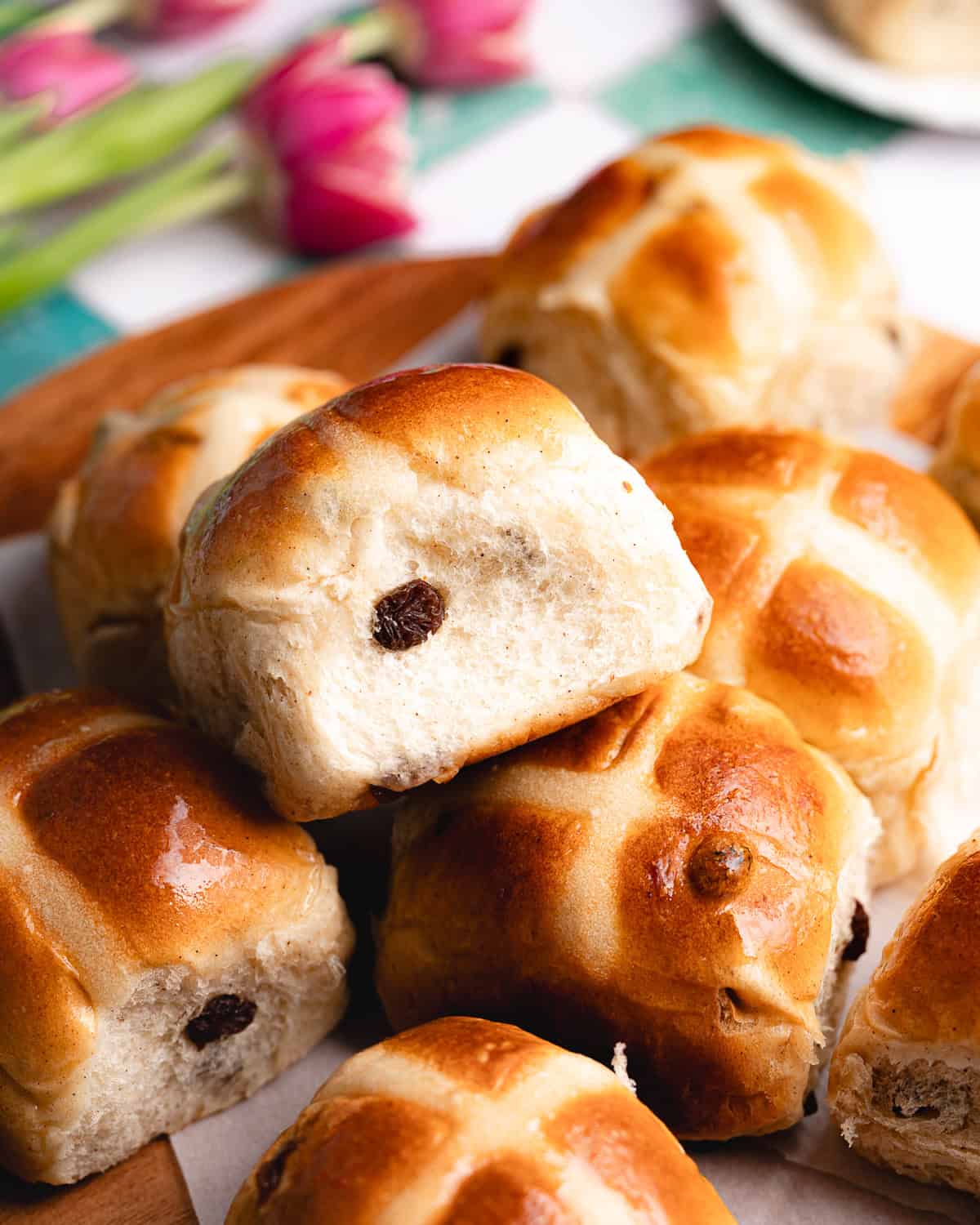
Love sweet sourdough bread recipes? Check out my recipes for Sourdough Sweet Potato Cinnamon Twist, Apple Sourdough Cinnamon Rolls and Sourdough Monkey Bread.
Recipe FAQs
Sourdough discard is any portion of your sourdough starter that you don't use to make bread. Instead of throwing it out, you can use it to make bread, cookies or cake recipes.
The yeast you used may have been expired or your dough most likely did not have enough time to rise. Make sure your dough has doubled in volume before shaping and baking.
Hot cross buns are soft and fluffy with a subtle warmth from the spices. Raisins and candied orange peel add bursts of natural sweetness throughout.
The intensity of flavor will vary depending on the acidity of your sourdough discard. However, since this dough doesn’t go through a long fermentation, it won’t develop much lactic or acetic acid—the compounds responsible for that signature sour flavor in traditional sourdough bread.
You may also like
Did this recipe rise to the occasion?
★★★★★
Please leave a star rating and a comment. Your feedback helps me create more delicious sourdough recipes. I read and truly appreciate every message.
Don't forget to PIN this recipe on Pinterest to save it for later!
Thank you for your support!
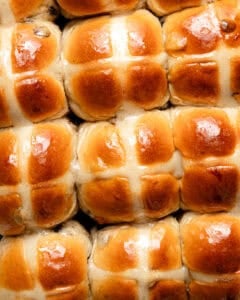
Sourdough Discard Hot Cross Buns
This section may contain affiliate links
Ingredients
Dough
- 7 grams yeast
- 50 grams granulated sugar
- 226 grams milk
- 1 egg
- 113 grams sourdough starter
- 480 grams bread flour
- 1 teaspoon cinnamon
- ½ teaspoon ground ginger
- ⅛ teaspoon grated nutmeg
- 1 whole clove ground
- 9 grams salt
- 56 grams butter
- 120 grams raisins
- 60 grams candied orange peel diced
Topping
- 40 grams all-purpose flour
- 7 grams powdered sugar
- 49 grams water
Simple Syrup
- 50 grams granulated sugar
- 56 grams water
Click US Customary to view volume measurements
Instructions
- Prep: Cover the bowl with plastic wrap and let the yeast bloom until foamy and fragrant, about 15 minutes. Transfer the raisins to a separate bowl and cover them with warm water.7 grams yeast, 50 grams granulated sugar, 226 grams milk, 120 grams raisins
- Make the dough: Whisk the egg and dissolve the sourdough discard into the yeast mixture. Stir in the flour, spices, and salt, and mix until a shaggy dough forms.1 egg, 113 grams sourdough starter, 480 grams bread flour, 1 teaspoon cinnamon, ½ teaspoon ground ginger, ⅛ teaspoon grated nutmeg, 1 whole clove, 9 grams salt
- Knead the butter into the dough. Your dough will be greasy at first and gradually feel smoother as the butter is absorbed.56 grams butter
- Cover the bowl with plastic wrap and let the dough rest for 10 minutes. This will make the dough less sticky and much easier to work with.
- Strengthen the dough: Turn the dough out onto a clean surface. Dust the surface with a little flour if your dough is too sticky to knead.
- Using the heel of your hand, push the dough away from you, then fold it back over itself. Give the dough a quarter turn and repeat. Knead the dough until smooth.
- Drain the raisins and blot them with paper towels to make sure most of the moisture is removed. You don't want to add more water to your dough or it will be too sticky and difficult to handle.
- Return the dough to the bowl and fold the raisins and chopped candied citrus into the dough until evenly distributed. Kneading the dough first helps keep the raisins and candied citrus intact, preventing them from getting smashed.60 grams candied orange peel
- Bulk fermentation: Gather the dough into a tight ball and transfer it to a clean, lightly oiled bowl. Cover the bowl with plastic wrap and let the dough rise untouched until doubled in volume, about 45 minutes to 1 hour.
- Shape the dough: Divide the dough into 12 portions. Working with one piece at a time, flatten the dough into a rectangle. Fold the corners toward the center, and pinch them together to seal. Turn the dough over and drag it on the work surface to round it into a tight ball, and try your best to seal the seam on the bottom. Repeat with the remaining dough portions.
- Final proof: Arrange the rolls in a 9 by 13-inch baking pan lined with parchment paper. Cover the pan with plastic wrap and let the dough rise untouched until puffy and almost fills the pan.
- Add the crosses: Make a paste out of the powdered sugar, all-purpose flour, and water.40 grams all-purpose flour, 7 grams powdered sugar, 49 grams water
- Transfer the topping to a piping bag. Pipe a straight line across the center of each row of buns, from one side of the pan to the other. Then pipe vertical lines down each column, intersecting the horizontal lines to form crosses.
- Bake: Bake the buns at 350°F for 45 to 50 minutes or until golden brown and the temperature of the buns registers at 190°F when probed with an instant-read thermometer.
- While the buns bake, heat water and sugar over medium heat until completely dissolved. Brush the warm buns with simple syrup.50 grams granulated sugar, 56 grams water
Tips
These recipes were developed and tested using grams for precise measurements. To increase your chances of success, I recommend investing in a kitchen scale. I've included rough volume estimates (in tablespoons and cups), but they might not be totally accurate.
Remember all ovens are unique, these recipes were tested in my oven which runs cooler than others. You might need to lower the temperature if your bake appears to be browning too quickly. Monitor your bake closely and make adjustments if needed.
Notes
- The windowpane test is a great way to check if your dough has developed enough strength. After kneading, stretch a small piece of dough between your fingers—if it forms a thin, translucent membrane without tearing, the dough is ready for the next step.
- You can use active starter for this recipe or just add 56 grams of water and 56 grams of flour to your dough.
- Both active dry yeast and instant yeast will work for this recipe. Feel free to skip blooming if you opt for instant yeast.
- Don't skip soaking the raisins. Dried fruit can steal moisture from the dough and mess with the final texture.
- If you can't fine candied citrus, feel free to add orange zest to the dough instead.
Nutrition
I am not a nutritionist or dietitian, any nutrition information provided is an estimate.

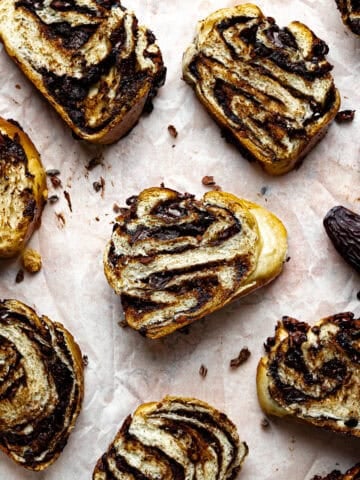
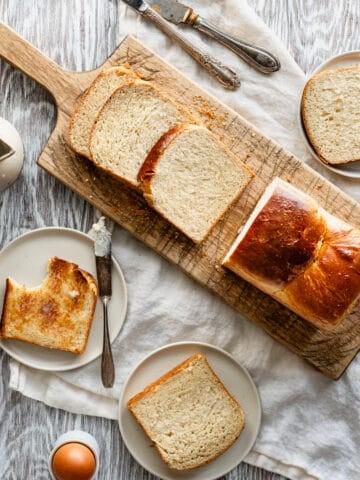

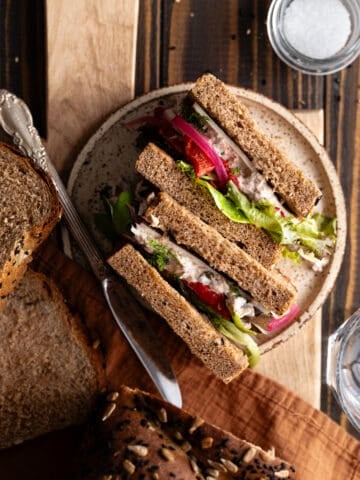
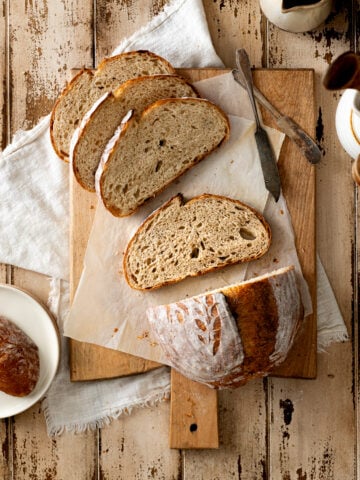



Did you make this recipe? Do you have questions? Let me know below!